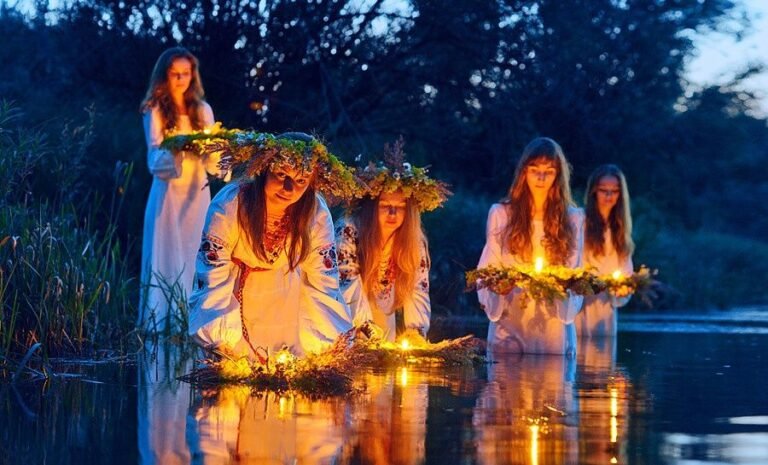Kupala Night (Belarusian: Купалле, Polish: Noc Kupały, Russian: Иван-Купала, Ukrainian: Івана Купала, Купайла), also called Ivana-Kupala, is a traditional holiday Slavic which was originally celebrated on the shortest night of the year, which is June 21-22 or 23-24 (Czech Republic, Poland and Slovakia) and in countries slavs Orientals according to the traditional Julian calendar on the night of July 6 to 7 (Belarus, Russia and Ukraine).
Contents
ToggleKupala, the shortest night
The name of the holiday was originally Kupala; a pagan fertility rite later adapted to the Orthodox Christian calendar by linking it to St. John's Day which is celebrated on June 24. Eastern Christianity uses the traditional Julian calendar which is misaligned with the actual solstice; June 24 in the Julian calendar falls on July 7 in the more modern Gregorian calendar.
This festival symbolizes the birth of the summer sun – Kupalo. In the 4th century AD, this day was proclaimed the feast of the birth of John the Baptist – the forerunner of Jesus Christ. As a result of the Christianization of the pagan holiday, the name "Kupala" became associated with the Christian "Ivan".
The Ukrainian and Belarusian name for this holiday combines "Ivan" (Joan/Johan/John, in this case John the Baptist) and Kupala, which was thought to be derived from the Slavic word for bathing, which is related. However, it probably comes from the Proto-Slavic kump, a gathering.
The two feasts could be linked by reinterpreting John's baptism of the people by total immersion in water. However, the Kupala tradition predates Christianity. The pagan celebration was adapted and reestablished as one of the indigenous Christian traditions intertwined with local folklore.
Many rites linked to this festival are linked to the role of water in fertility and ritual purification. This is due to the ancient Kupala rites. On Kupala, young people jump over the flames of bonfires in a ritual test of bravery and faith. The failure of a loving couple to complete the jump, while holding hands, is a sign of their destined separation.
Girls can float flower crowns (often lit with candles) on rivers and attempt to predict the fortunes of their romantic relationship from the flow patterns of flowers on the river. Men may attempt to capture the wreaths, hoping to capture the interest of the woman who floated them.
There is an ancient Kupala belief that the eve of Ivan Kupala is the only time of the year when ferns bloom. Prosperity, luck, discernment and power come to anyone who finds a fern flower. Therefore, that night, the villagers roam the forests in search of magical herbs, and in particular the elusive fern flower.
Traditionally, single women, signified by the garlands in their hair, are the first to enter the forest. They are followed by young men. Therefore, the quest to find herbs and the fern flower can lead to the blossoming of relationships between couples within the forest.
In Gogol's story The Eve of Ivan Kupala (also called Saint John's Eve), a young man finds the fern fantastic, but is cursed by it. Gogol's tale was adapted by Yuri Ilyenko into a film of the same name and may have inspired Modest Mussorgsky to compose his tone poem Night on Bald Mountain.
Here is the text of our social networks:
Today, the Slavs celebrate Kupala night. This ancestral festival is today replaced by Saint John's Day. This festival celebrates fire, water, the Sun and Moon, the harvest, fertility, joy and love. Its origin is linked to the cult of Kupala. #mythology #myth #legend #calendar #23June July #6 #kupala
